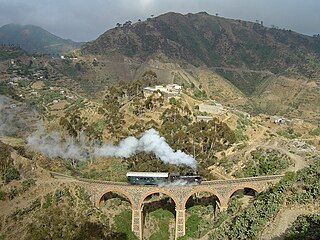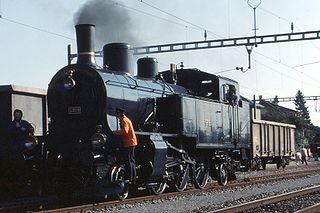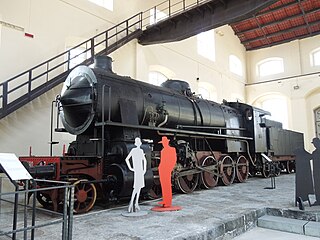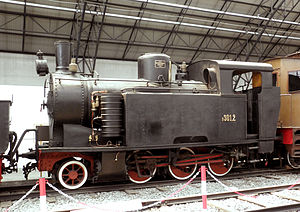
The Eritrean Railway is the only railway system in Eritrea. It was constructed between 1887 and 1932 during the Italian Eritrea colony and connects the port of Massawa with Asmara. Originally it also connected to Bishia. The line was partly damaged by warfare in subsequent decades, but was rebuilt in the 1990s. Vintage equipment is still used on the line.
Indian Railways operates India's railway system and comes under the purview of the Ministry of Railways of Government of India. As of 2023, it maintains over 108,706 km (67,547 mi) of tracks and operates over 13,000 trains daily with a fleet of 14,800 locomotives. The railways primarily operates a fleet of electric and diesel locomotives along with a few compressed natural gas (CNG) locomotives. Steam locomotives are operated on mountain railways and on heritage trains.

For more than a century, the Swiss locomotive, multiple unit, motor coach and railcar classification system, in either its original or updated forms, has been used to name and classify the rolling stock operated on the railways of Switzerland. It started out as a uniform system for the classification and naming of all rolling stock, powered and unpowered, but had been replaced and amended by the UIC classification of goods wagons.

The Ferrovie dello Stato Class 685 is a class of 2-6-2 'Prairie' express train steam locomotives. These are colloquially known as Regine, mirroring their fame as one of the most successful and appreciated Italian steam locomotives.

The Ferrovie dello Stato Italiane Class 691 is a class of 4-6-2 'Pacific' locomotives; they were the fastest and most powerful locomotives ever built for the Italian railways.

The Ferrovie dello Stato Italiane Class 690 was a 4-6-2 'Pacific' steam locomotive for express trains.

The Ferrovie dello Stato Italiane Class 470 is a 0-10-0 steam locomotive.

The Ferrovie dello Stato Class 480 is a 2-10-0 steam locomotive.

The Ferrovie dello Stato Italiane Class 940 is a 2-8-2 steam tank locomotive, derived from the Class 740 tender locomotive.

The Ferrovie dello Stato Italiane Class 835 is a 0-6-0T steam locomotive; it was the standard steam shunter of the FS.

The Ferrovia Alta Valtellina (FAV) is a railway line in Italy which connects Sondrio, in Valtellina, to Tirano in Alta Valtellina. The railway company was established in 1899 and the line opened in 1902. Many railways in Italy were nationalized in 1905 but the Ferrovia Alta Valtellina escaped and was not nationalized until 1970.

The Ferrovie dello Stato Class 741 is a class of 2-8-0 'Consolidation' steam locomotives, rebuilds from the FS Class 740 with a Franco-Crosti boiler; it was the last class of steam locomotives introduced in Italy.

FS Class E.321 was a class of 17 third-rail electric locomotives, built for the Italian State Railways (FS) for operation on the Varese line and on the underground line in Naples.
CEMSA was an Italian engineering company which operated from 1925 to 1948.
The Società della Ferrovia Sicula Occidentale was established in 1878 to construct a railway between Palermo, Marsala and Trapani.
FS Class 410 were 0-8-0 steam locomotives which the Italian State Railways (FS) acquired from Rete Sicula on nationalization in 1906.

The Ferrovie dello Stato Class 744 is a class of 2-8-0 steam locomotives; they were the last orthodox steam locomotives built for the FS.

Sicily had at one time an extensive narrow gauge railway network. The design work was begun under at the time of the provisional management of the Southern Railways, continued by the Rete Sicula and built by Ferrovie dello Stato, which spread over the territory of five provinces: Palermo, Trapani, Agrigento, Caltanissetta, Enna; today the FS narrow-gauge network is completely abandoned and only the Circumetnea railway survives.

Sicily'srail network, which has included only standard-gauge lines since 1986, is operated entirely by Rete Ferroviaria Italiana; an exception is the 111-km narrow-gauge Catania-Randazzo-Linguaglossa-Riposto line, which is operated by Ferrovia Circumetnea. As of 2018, the FS network in operation covers a length of 1369 km.

Class 851 locomotives were a class of steam locomotives of the Italian State Railways (FS).
















